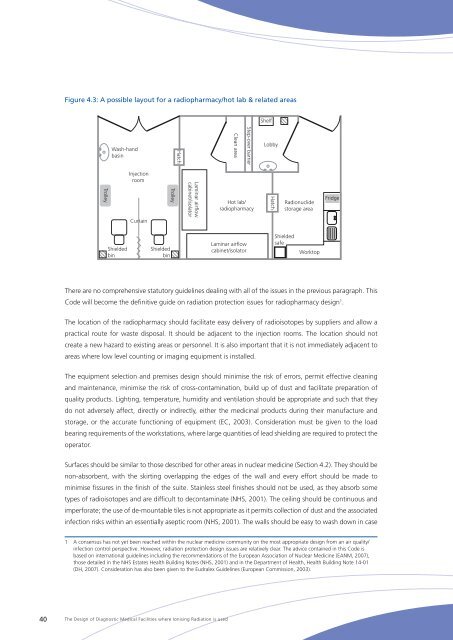The Design of Diagnostic Medical Facilities where ... - ResearchGate
The Design of Diagnostic Medical Facilities where ... - ResearchGate
The Design of Diagnostic Medical Facilities where ... - ResearchGate
Create successful ePaper yourself
Turn your PDF publications into a flip-book with our unique Google optimized e-Paper software.
Figure 4.3: A possible layout for a radiopharmacy/hot lab & related areas<br />
Shelf<br />
Wash-hand<br />
basin<br />
Hatch<br />
Clean area<br />
Step-over barrier<br />
Lobby<br />
Trolley<br />
Injection<br />
room<br />
Curtain<br />
Trolley<br />
Laminar airflow<br />
cabinet/isolator<br />
Hot lab/<br />
radiopharmacy<br />
Hatch<br />
Radionuclide<br />
storage area<br />
Fridge<br />
Shielded<br />
bin<br />
Shielded<br />
bin<br />
Laminar airflow<br />
cabinet/isolator<br />
Shielded<br />
safe<br />
Worktop<br />
<strong>The</strong>re are no comprehensive statutory guidelines dealing with all <strong>of</strong> the issues in the previous paragraph. This<br />
Code will become the definitive guide on radiation protection issues for radiopharmacy design .<br />
<strong>The</strong> location <strong>of</strong> the radiopharmacy should facilitate easy delivery <strong>of</strong> radioisotopes by suppliers and allow a<br />
practical route for waste disposal. It should be adjacent to the injection rooms. <strong>The</strong> location should not<br />
create a new hazard to existing areas or personnel. It is also important that it is not immediately adjacent to<br />
areas <strong>where</strong> low level counting or imaging equipment is installed.<br />
<strong>The</strong> equipment selection and premises design should minimise the risk <strong>of</strong> errors, permit effective cleaning<br />
and maintenance, minimise the risk <strong>of</strong> cross-contamination, build up <strong>of</strong> dust and facilitate preparation <strong>of</strong><br />
quality products. Lighting, temperature, humidity and ventilation should be appropriate and such that they<br />
do not adversely affect, directly or indirectly, either the medicinal products during their manufacture and<br />
storage, or the accurate functioning <strong>of</strong> equipment (EC, 2003). Consideration must be given to the load<br />
bearing requirements <strong>of</strong> the workstations, <strong>where</strong> large quantities <strong>of</strong> lead shielding are required to protect the<br />
operator.<br />
Surfaces should be similar to those described for other areas in nuclear medicine (Section 4.2). <strong>The</strong>y should be<br />
non-absorbent, with the skirting overlapping the edges <strong>of</strong> the wall and every effort should be made to<br />
minimise fissures in the finish <strong>of</strong> the suite. Stainless steel finishes should not be used, as they absorb some<br />
types <strong>of</strong> radioisotopes and are difficult to decontaminate (NHS, 2001). <strong>The</strong> ceiling should be continuous and<br />
imperforate; the use <strong>of</strong> de-mountable tiles is not appropriate as it permits collection <strong>of</strong> dust and the associated<br />
infection risks within an essentially aseptic room (NHS, 2001). <strong>The</strong> walls should be easy to wash down in case<br />
<br />
A consensus has not yet been reached within the nuclear medicine community on the most appropriate design from an air quality/<br />
infection control perspective. However, radiation protection design issues are relatively clear. <strong>The</strong> advice contained in this Code is<br />
based on international guidelines including the recommendations <strong>of</strong> the European Association <strong>of</strong> Nuclear Medicine (EANM, 2007),<br />
those detailed in the NHS Estates Health Building Notes (NHS, 2001) and in the Department <strong>of</strong> Health, Health Building Note 14-01<br />
(DH, 2007). Consideration has also been given to the Eudralex Guidelines (European Commission, 2003).<br />
40<br />
<strong>The</strong> <strong>Design</strong> <strong>of</strong> <strong>Diagnostic</strong> <strong>Medical</strong> <strong>Facilities</strong> <strong>where</strong> Ionising Radiation is used
















